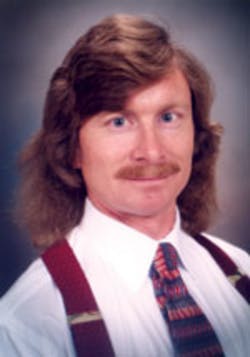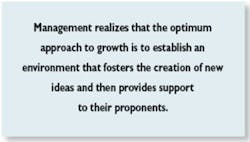Encouraging Entrepreneurship
In today�s very competitive market-driven environment, every company, whether large or small, stakes its survival on being able to respond to market needs with a combination of technical integrity, competitive pricing, and rapid time-to-market. Like other large corporations, EADS North America Defense Test and Services has a long history of fostering entrepreneurial initiative.
Management realizes that the optimum approach to growth is to establish an environment that fosters the creation of new ideas and then provides support to their proponents. By combining the availability of extensive resources with processes that facilitate rapid development cycles, new products and services go quickly from concept to first article, ready to be tested by the rigors of the marketplace.
A Few Examples
Our company�s history is largely one of serial entrepreneurship. The following cases illustrate how the combination of an entrepreneurial environment, management support, vast resources, and a focus on time-to-market have led to more than 30 years of success in the test and measurement market.
In response to an RFP from a leading semiconductor manufacturer, a senior engineer working with the approval and support of company management put together a team of hardware, software, and mechanical engineers who designed a microprocessor test system. Prior to this, the company had no experience in semiconductor test.
The first system was brought from concept to first article in only 15 months with the aid of the company�s purchasing, planning, and manufacturing groups. The unit was delivered to the customer where it was installed and benchmarked against a competitive unit. The engineer�s system won the bake-off, which has led to several hundred million dollars of follow-on business with the customer.
In another instance, a cross-functional group of entrepreneurial employees consisting of EEs, MEs, software engineers, a marketer, and a sales engineer formed a new group within the company to focus on optical test and device burn-in. Backed with more than $1M of seed capital from management, the group developed, marketed, and sold optical burn-in and test systems, moving from concept to a complete product line in approximately 18 months.
Over a period of two years, the business-within-a-business grew to contribute a significant portion of the total company�s sales. The initial team went on to hire additional design engineers, manufacturing personnel, and sales engineers as the product line and customer base expanded.
In a final example, a senior engineer was contacted by a customer to bid on a high-throughput next-generation burn-in and test system for semiconductors. The engineer enlisted the assistance of a number of cross-functional resources within the company and developed several initial design concepts.
The unit required the integration of advanced robotics, state-of-the-art control, and enterprise resource planning (ERP) interface software that facilitated running concurrent tests on hundreds of DUTS independently. Additionally, high-power electronics and cutting-edge thermal management technologies involving closed-loop refrigerant and heat-transfer technologies were required.
Coincidentally, a number of patent applications were generated by engineers during the project. The resulting product continues to be purchased, deployed, and used by the customer at sites around the world.
Several common threads may be noted in these examples. First and foremost, the company fosters an entrepreneurial environment where employees are encouraged to develop new concepts or take the proverbial ball from the customer and run.
Second, management rapidly evaluates the situation and, if it makes good business sense, invests in the idea. This not only provides the engineer with the resources required to achieve success, but also ensures the company remains market-driven.
Finally, to bring the product to market, the company leverages its financial resources to develop and manufacture it. A number of best-in-class large companies that have continued to prosper and grow through the years have evolved similar cultures and processes.
International Intrigue
Working in a large multinational company also brings with it the opportunity to work with customers and colleagues across the globe, often leading to long-term partnerships and friendships and more than a few frequent-flyer miles. Seeking to maximize the use of skills and facilities throughout the larger corporation, our parent company, a $40B, 110,000 employee defense and aerospace corporation, actively works to form bridges among divisions and groups across the globe.
Teams in the United States often collaborate on projects with colleagues in France, the United Kingdom, Italy, and Germany as well as with other groups within the United States. On a recent digital I/O subsystem project, product specifications and software development originated in France, hardware design and manufacturing were performed in California, and units were deployed worldwide. In another example, sales engineers in the United Kingdom worked with design engineers in the United States to provide custom microwave subsystems for satcom applications for a customer in India.
Staying Power
Much of the work at our company is targeted toward the military aerospace market where customers require technical integrity and long-term commitment to product support. Some military and aerospace platforms live on for many decades.
The B-52, for example, will be 86 years old when it is retired in 2040. Long-lived military platforms require test and measurement products that will be operational for decades. In many instances, customers rely on the stability and longevity of large companies to provide long-term support.
Global Support
A larger company also has the resources to develop and maintain service centers around the world. As with other global concerns, our company operates centers throughout Europe, Asia, and the United States, facilitating 24/7/365 local assistance to our customers.
We even provide on-site support onboard U.S. Navy ships while on deployment anywhere in the world. The members of our service team have accumulated a wealth of experience worldwide.
Wrap-Up
Today�s test and measurement market is more competitive than ever. Time-to-market, technical innovation, and first-class service are all requirements for continued success.
It is widely believed that smaller companies have the capability to bring innovative products to market more rapidly than their larger counterparts. By fostering a culture of entrepreneurship together with rapid decision making, deep resource pools, and processes oriented to reduce development and deployment cycle times, large companies can outcompete even the most nimble small company.
About the Author
Mark Minot has held a variety of posts at EADS North America Defense Test and Services including vice president of engineering and vice president of functional test as well as business unit leadership positions for the broadband/photonic and functional test and instruments business units. Most recently, he has led the group responsible for business strategy development, mergers and acquisitions, and partnership activities for the company. He holds B.S.E.E., M.S.E.E., and Ph.D. degrees in electrical engineering in addition to a master�s degree in business administration. EADS North America Defense Test and Services, 4 Goodyear St., Irvine, CA 92618, 949-460-6846, e-mail: [email protected]
February 2007


